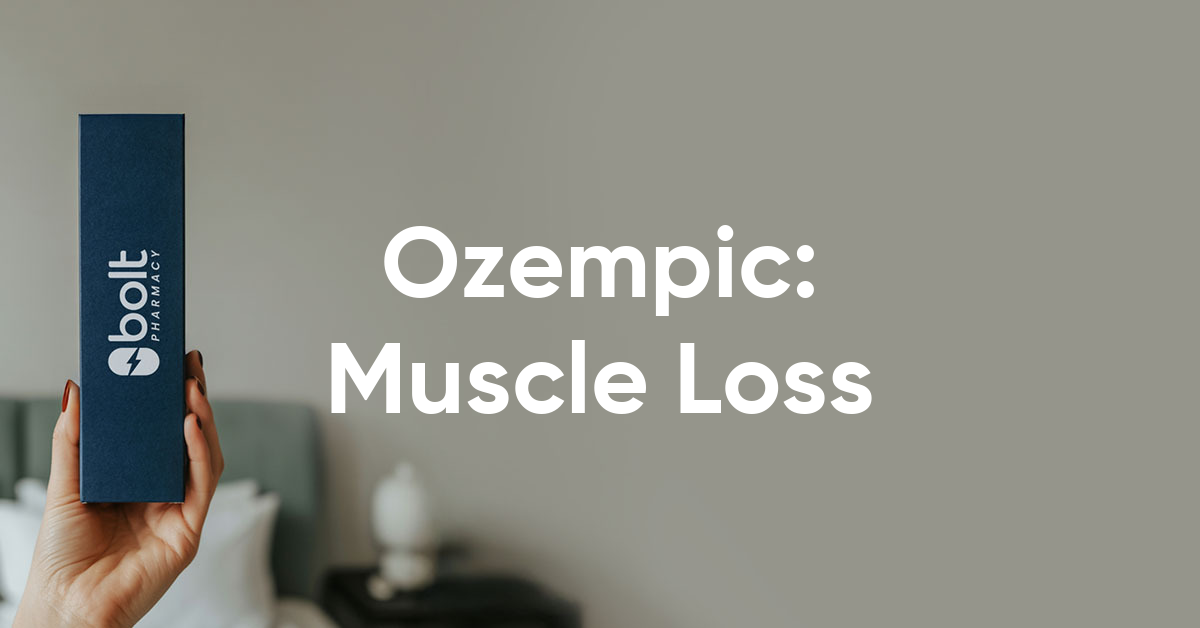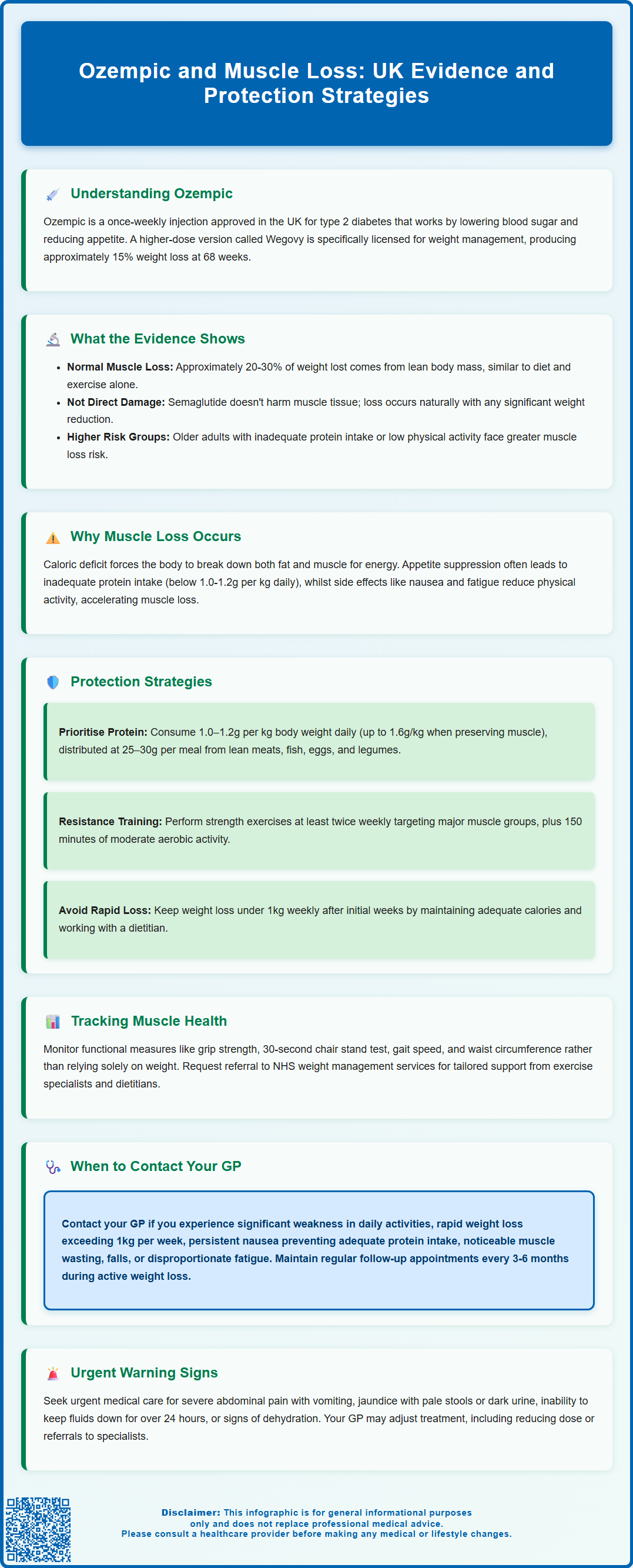Wegovy®
Similar to Ozempic, Wegovy also contains semaglutide but is licensed for weight management. It helps reduce hunger and supports meaningful, long-term fat loss.
- Supports clinically proven weight reduction
- Weekly injection, easy to use

Ozempic (semaglutide) has gained attention for its weight loss effects, but concerns about muscle loss during treatment are increasingly discussed. Whilst Ozempic is licensed in the UK for type 2 diabetes management, evidence shows that approximately 20-30% of weight lost may come from lean body mass—comparable to diet and exercise alone. This muscle loss appears related to the weight reduction process itself rather than direct drug effects on muscle tissue. Understanding how to preserve muscle mass through adequate protein intake, resistance training, and proper monitoring is essential for patients using semaglutide, whether for diabetes control or weight management under specialist supervision.
Summary: Ozempic can contribute to muscle loss, but this occurs primarily as part of overall weight reduction rather than through direct muscle damage, with approximately 20-30% of weight lost coming from lean body mass.
Ozempic (semaglutide) is a prescription medicine licensed in the UK for the treatment of type 2 diabetes mellitus. It belongs to a class of drugs called glucagon-like peptide-1 (GLP-1) receptor agonists, which work by mimicking a naturally occurring hormone that regulates blood sugar levels and appetite.
The mechanism of action involves several key processes:
Stimulating insulin secretion from the pancreas when blood glucose levels are elevated
Suppressing glucagon release, which reduces glucose production by the liver
Slowing gastric emptying, meaning food remains in the stomach longer, promoting feelings of fullness
Acting on appetite centres in the brain to reduce hunger and food intake
Whilst Ozempic is primarily indicated for glycaemic control in type 2 diabetes as an adjunct to diet and exercise, it has gained considerable attention for its weight loss effects. Clinical trials have demonstrated that patients using Ozempic typically experience modest weight reductions as a secondary benefit. A higher-dose formulation called Wegovy (also semaglutide, 2.4mg) is specifically licensed for chronic weight management in the UK, with clinical trials showing approximately 15% weight loss at 68 weeks (STEP trials).
Importantly, NHS England has issued a National Patient Safety Alert advising against off-label prescribing of Ozempic for weight loss due to supply constraints for patients with diabetes.
Ozempic is administered as a once-weekly subcutaneous injection, with doses gradually increased from 0.25 mg to a maintenance dose of 0.5 mg, 1 mg, or 2 mg, depending on individual response and tolerability. According to the Summary of Product Characteristics (SmPC), Ozempic should be used alongside diet and exercise for optimal glycaemic control. Common side effects include nausea, vomiting, diarrhoea, and constipation, which typically improve over time as the body adjusts to treatment.
Access to Wegovy for weight management in the UK is governed by NICE Technology Appraisal 875, which specifies eligibility criteria including BMI thresholds with comorbidity adjustments, specialist service setting, and a maximum treatment duration of 2 years.

The relationship between Ozempic and muscle loss has become a topic of clinical interest as more patients use GLP-1 receptor agonists for weight management. Current evidence suggests that muscle loss can occur during treatment with semaglutide, but this appears to be primarily related to the overall weight loss process rather than a direct drug effect on muscle tissue.
Clinical trial data reveals important findings:
STEP-1 DEXA substudy data shows that approximately 20-30% of weight lost with semaglutide may come from lean body mass (fat-free soft tissue, excluding bone mineral content)
This proportion is actually comparable to or slightly better than what occurs with diet and exercise alone for equivalent weight loss
Research published in medical journals indicates that the absolute amount of muscle lost is greater with semaglutide simply because total weight loss is substantially higher
There is no evidence that semaglutide directly damages or breaks down muscle tissue through its pharmacological action
A key consideration is that any significant weight loss—regardless of method—typically involves some degree of lean mass reduction. When the body is in a caloric deficit, it draws on both fat stores and lean tissue for energy. The challenge with rapid or substantial weight loss is maintaining muscle mass whilst preferentially losing fat.
Recent observational studies have raised questions about potential sarcopenia (age-related muscle loss) in older adults using GLP-1 agonists, particularly when combined with inadequate protein intake or physical inactivity. However, these findings require further investigation, and regulatory bodies including the MHRA continue to monitor safety data through the Yellow Card scheme. The benefits of weight loss for metabolic health should be discussed with healthcare professionals on an individual basis, considering personal risk factors and circumstances.
Understanding the physiological mechanisms behind muscle loss during weight reduction is essential for both patients and healthcare professionals. Muscle loss during treatment with Ozempic is multifactorial and relates to several interconnected processes.
Caloric deficit and metabolic adaptation form the primary mechanism. When taking semaglutide, patients typically consume significantly fewer calories due to reduced appetite and early satiety. In this energy-deficient state, the body must mobilise stored energy. Whilst fat is the preferred fuel source, the body simultaneously breaks down some muscle protein through a process called proteolysis. This is a normal metabolic response to weight loss, not a specific drug effect.
Reduced protein intake often accompanies appetite suppression. Many patients report difficulty consuming their usual food volumes, and protein-rich foods may be particularly challenging due to their satiating effects. When dietary protein falls below approximately 1.0–1.2 grams per kilogram of body weight daily (potentially higher in those actively trying to preserve muscle), the body cannot adequately maintain muscle protein synthesis, leading to net muscle loss. Patients with chronic kidney disease may require lower protein intakes and should seek dietitian advice.
Decreased physical activity may occur for several reasons:
Gastrointestinal side effects (nausea, fatigue) reducing exercise tolerance
Rapid weight loss causing temporary weakness or lethargy
Patients relying solely on medication without maintaining exercise routines
Reduced overall movement due to feeling unwell during dose adjustments
Hormonal and metabolic changes during significant weight loss also play a role. Changes in insulin levels and other metabolic factors can influence muscle protein turnover. Additionally, older adults and those with pre-existing low muscle mass are at higher risk of clinically significant muscle loss during any weight reduction programme, as outlined in the European Working Group on Sarcopenia in Older People (EWGSOP2) consensus.
Preserving muscle mass during treatment with semaglutide requires a proactive, multifaceted approach that addresses nutrition, physical activity, and monitoring. Evidence-based strategies can significantly improve body composition outcomes.
Optimise protein intake is the cornerstone of muscle preservation:
Aim for 1.0–1.2 grams of protein per kilogram of body weight daily as a general target
This may increase to 1.2–1.6 g/kg/day when actively trying to preserve muscle, if clinically appropriate
Important: patients with chronic kidney disease should discuss protein targets with their healthcare team
Distribute protein across all meals (approximately 25–30 grams per meal)
Choose high-quality protein sources: lean meats, fish, eggs, dairy products, legumes, and protein supplements if needed
Consider protein-rich snacks if appetite is reduced at main meals
Prioritise protein consumption even when feeling full or nauseous
Implement resistance training as this is the most effective intervention for maintaining muscle:
Engage in resistance exercises at least 2 times weekly, in line with UK Chief Medical Officers' Physical Activity Guidelines
Focus on major muscle groups using weights, resistance bands, or bodyweight exercises
Progressive overload (gradually increasing resistance) stimulates muscle protein synthesis
Aim for 150 minutes of moderate aerobic activity weekly alongside resistance training
Even modest resistance training significantly improves lean mass retention during weight loss
Maintain adequate overall nutrition despite reduced appetite:
Work with a dietitian to ensure nutritional adequacy within a reduced-calorie framework
Consider vitamin D and calcium supplementation, particularly if dairy intake is low
Ensure sufficient caloric intake—excessively rapid weight loss (>1 kg weekly after the initial 2-4 weeks) increases muscle loss risk
Monitor body composition changes through practical measures such as waist circumference, grip strength (using a hand dynamometer if available), 30-second chair stand test, and gait speed alongside weight. These functional measures can help track muscle strength even without specialised equipment.
NICE guidance (TA875) emphasises the importance of combining pharmacotherapy with lifestyle interventions. Patients should discuss referral to NHS weight management services, which often include exercise specialists and dietitians who can provide tailored support for muscle preservation during treatment.
Recognising when muscle changes require medical attention is crucial for patient safety and treatment optimisation. Whilst some lean mass reduction may be expected during significant weight loss, certain signs warrant prompt discussion with your GP or diabetes specialist.
Contact your GP if you experience:
Significant weakness affecting daily activities (difficulty climbing stairs, rising from chairs, carrying shopping)
Rapid or excessive weight loss (more than 1 kg per week consistently after the initial 2-4 weeks)
Difficulty consuming adequate protein due to persistent nausea or vomiting
Noticeable muscle wasting, particularly in the arms, legs, or shoulders
Falls or balance problems that may indicate reduced muscle strength
Fatigue or exhaustion disproportionate to your activity level
Concerns about nutritional adequacy or inability to maintain a balanced diet
Seek urgent medical care if you develop:
Severe, persistent abdominal pain (especially if accompanied by vomiting)
Jaundice (yellowing of skin/eyes), pale stools, or dark urine
Inability to keep fluids down for more than 24 hours
Reduced urine output, dizziness, or signs of dehydration
Your GP may consider several investigations and interventions:
Body composition assessment where available, or functional measures like grip strength and chair stand tests
Blood tests including full blood count, renal function, liver function, thyroid function, vitamin D levels, and HbA1c (for diabetes monitoring)
Review of medication dosing—sometimes reducing the semaglutide dose or slowing titration can improve tolerability
Referral to a dietitian for specialised nutritional support and meal planning
Referral to physiotherapy or exercise programmes for supervised resistance training
Assessment for sarcopenia in older adults using validated screening tools such as SARC-F
Treatment adjustments may be necessary if muscle loss is excessive or causing functional impairment. This might include temporarily pausing dose increases, implementing a structured nutrition and exercise plan, or in some cases, discontinuing semaglutide if risks outweigh benefits.
Patients should maintain regular follow-up appointments as recommended by their healthcare team—typically every 3–6 months during active weight loss. This allows monitoring of both beneficial effects (weight loss, improved glycaemic control) and potential adverse effects, ensuring treatment remains safe and appropriate for individual circumstances.
No, Ozempic does not directly damage or break down muscle tissue through its pharmacological action. Muscle loss occurs as part of the overall weight reduction process, similar to what happens with diet and exercise alone for equivalent weight loss.
Clinical trial data shows approximately 20-30% of weight lost with semaglutide may come from lean body mass, which is comparable to or slightly better than diet and exercise alone for similar weight loss amounts.
Key strategies include consuming 1.0-1.2 grams of protein per kilogram of body weight daily, performing resistance training at least twice weekly, maintaining adequate overall nutrition, and monitoring body composition changes with your healthcare team.
The health-related content published on this site is based on credible scientific sources and is periodically reviewed to ensure accuracy and relevance. Although we aim to reflect the most current medical knowledge, the material is meant for general education and awareness only.
The information on this site is not a substitute for professional medical advice. For any health concerns, please speak with a qualified medical professional. By using this information, you acknowledge responsibility for any decisions made and understand we are not liable for any consequences that may result.
Lorem ipsum dolor sit amet, consectetur adipiscing elit, sed do eiusmod tempor incididunt ut labore et dolore magna aliqua. Ut enim ad minim veniam, quis nostrud exercitation ullamco laboris nisi ut aliquip ex ea commodo consequat. Duis aute irure dolor in reprehenderit in voluptate velit esse cillum dolore eu fugiat nulla pariatur.
Block quote
Ordered list
Unordered list
Bold text
Emphasis
Superscript
Subscript